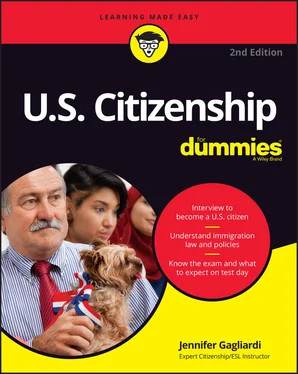Jennifer Gagliardi - U.S. Citizenship For Dummies
Здесь есть возможность читать онлайн «Jennifer Gagliardi - U.S. Citizenship For Dummies» — ознакомительный отрывок электронной книги совершенно бесплатно, а после прочтения отрывка купить полную версию. В некоторых случаях можно слушать аудио, скачать через торрент в формате fb2 и присутствует краткое содержание. Жанр: unrecognised, на английском языке. Описание произведения, (предисловие) а так же отзывы посетителей доступны на портале библиотеки ЛибКат.
- Название:U.S. Citizenship For Dummies
- Автор:
- Жанр:
- Год:неизвестен
- ISBN:нет данных
- Рейтинг книги:3 / 5. Голосов: 1
-
Избранное:Добавить в избранное
- Отзывы:
-
Ваша оценка:
- 60
- 1
- 2
- 3
- 4
- 5
U.S. Citizenship For Dummies: краткое содержание, описание и аннотация
Предлагаем к чтению аннотацию, описание, краткое содержание или предисловие (зависит от того, что написал сам автор книги «U.S. Citizenship For Dummies»). Если вы не нашли необходимую информацию о книге — напишите в комментариях, мы постараемся отыскать её.
U.S. Citizenship For Dummies
U.S. Citizenship For Dummies
U.S. Citizenship For Dummies — читать онлайн ознакомительный отрывок
Ниже представлен текст книги, разбитый по страницам. Система сохранения места последней прочитанной страницы, позволяет с удобством читать онлайн бесплатно книгу «U.S. Citizenship For Dummies», без необходимости каждый раз заново искать на чём Вы остановились. Поставьте закладку, и сможете в любой момент перейти на страницу, на которой закончили чтение.
Интервал:
Закладка:
A joint sponsor must meet the same sponsorship qualifications as the sponsoring relative with one important exception: The joint sponsor does not need to be a relative of any kind (they can be, but that isn’t required in order for the person to qualify).
 The joint sponsor (or the joint sponsor and their household) must meet the 125 percent income requirement on their own. You can’t combine your income with that of a joint sponsor to meet the income requirement the way you can with your primary sponsor.
The joint sponsor (or the joint sponsor and their household) must meet the 125 percent income requirement on their own. You can’t combine your income with that of a joint sponsor to meet the income requirement the way you can with your primary sponsor.
So how much is 125 percent above the mandated poverty level? The U.S. Department of Health and Human Services sets the annual poverty guidelines. For more information about financial support, visit the following resources:
USCIS document “How do I financially sponsor someone who wants to immigrate?” ( www.uscis.gov/sites/default/files/document/guides/F3en.pdf )
USCIS I-864, Affidavit of Support Under Section 213A of the INA ( www.uscis.gov/i-864 )
USCIS I-864P, 2022 HHS Poverty Guidelines for Affidavit of Support ( www.uscis.gov/i-864p )
HHS Poverty Guidelines ( https://aspe.hhs.gov/topics/poverty-economic-mobility/poverty-guidelines )
Note the difference between the contiguous 48 states and U.S. territories compared to Alaska and Hawaii.
Identifying exceptions to the sponsorship requirements
As with all things related to U.S. immigration, there are exceptions to most rules, including the family member sponsorship requirements.
If you are the immigrant, and you can prove you’ve already legally worked in the United States a total of at least 40 qualifying quarters, as defined in Title II of the Social Security Act, an affidavit of support is not required. Because rules related to means-tested public assistance benefits changed in October 2021, see the following instructions for updates: USCIS Form I-864W Instructions for Request for Exemption for Intending Immigrant’s Affidavit of Support ( www.uscis.gov/sites/default/files/document/forms/i-864winstr.pdf ).
If the immigrant is the child of a citizen and if the immigrant, if admitted for permanent residence on or after February 27, 2001, would automatically acquire citizenship under the Immigration and Nationality Act, as amended by the Child Citizenship Act of 2000, they are exempt from sponsorship requirements. Approved in October 2000 by President Clinton, the Child Citizenship Act of 2000 states that a child born outside the United States automatically becomes a citizen of the U.S. when all the following conditions apply:
At least one parent of the child is a citizen of the United States, either born or naturalized.
The child is under 18 years old.
The child is living in the United States in the legal and physical custody of the citizen parent after being admitted as a lawful permanent resident.
It’s important to realize that in order to qualify under the Child Citizenship Act, an applicant must have met all three of the preceding requirements on or after February 27, 2001. If an applicant meets all the requirements except that their 18th birthday fell before February 27, 2001, the applicant legally remains an alien until they can go through the normal naturalization process as outlined in this book.
Working for a Green Card
A second goal of the U.S. immigration system is to allow U.S. employers to hire citizens of other countries when no qualified U.S. citizens or legal residents can fill the positions. Each year, a minimum of 140,000 employment-based immigrant visas become available in five preference categories.
In most cases, you will need a solid offer of employment from a qualified employer who is willing and able to sponsor you for immigration. In addition to filing forms and guaranteeing employment, in many cases the employer should also be prepared to show evidence that no qualified U.S. citizens or lawful permanent residents are available to fill the position.
After determining if you qualify for an employment-based visa, you and your employer will usually be required to obtain a labor certification from the U.S. Department of Labor (Form ETA 750), as well as file an Immigrant Petition for Foreign Worker (Form I-140) with the USCIS. As always, you’ll probably have to file other forms and paperwork — you can find more on this in Chapter 4.
Making sense of employment preference categories
Just as with family-based visas, U.S. immigration laws allow people to gain lawful permanent residence legally through several preference categories. See USCIS Green Card for Employment-Based Immigrants ( www.uscis.gov/green-card/green-card-eligibility/green-card-for-employment-based-immigrants ) or Employment-Based Immigrant Visas ( https://travel.state.gov/content/travel/en/us-visas/immigrate/employment-based-immigrant-visas.html ).
First preference: Priority workers
Priority workers receive 28.6 percent of the yearly worldwide allotment of employment visas, plus any left over from the fourth and fifth preference categories. Within this preference category, you’ll find three subgroups. Although qualifying for a first preference visa is quite difficult, none of these categories requires labor certification, which saves processing time.
PEOPLE WITH EXTRAORDINARY ABILITY
 In order to qualify in this category, be prepared to prove your extraordinary ability or past employment record to qualify.
In order to qualify in this category, be prepared to prove your extraordinary ability or past employment record to qualify.
If you can offer extensive documentation showing sustained national or international acclaim and recognition as a person of extraordinary ability in the sciences, arts, education, business, or athletics, you won’t be required to have a specific job offer or a sponsoring employer to immigrate to the United States — provided you’re coming here to continue work in your established field. An employer can petition for you, however.
Keep in mind that the first priority classification is reserved for those with truly extraordinary achievement (for instance, Nobel Prize winners). If you haven’t yet won such a prestigious award, other documentation that can help you prove your case as a person of extraordinary ability includes
Receipt of nationally or internationally recognized prizes or awards for excellence in your field
Membership in associations that demand outstanding achievement of their members
Published material about yourself in professional or major trade publications or other major media attention
Evidence that you have judged the work of others, individually or as a member of a professional panel
Evidence of contributions of major significance to your field
Evidence of authorship of scholarly articles in professional or major trade publications or other major media
Evidence that your work has been displayed at artistic, business, educational, scientific, or athletic exhibitions or showcases
Evidence that you perform a leading or critical role in distinguished professional organizations
Evidence that you command a high salary in relation to others in your field
Evidence of your commercial successes in your field
Other comparable evidence
OUTSTANDING PROFESSORS OR RESEARCHERS
No labor certification is required if you can prove to the satisfaction of the USCIS that you are an internationally recognized outstanding professor or researcher with at least three years’ experience in teaching or research. You must be entering the United States in a tenure or tenure-track teaching capacity or in a comparable research position at a university or other institution of higher learning. If your prospective employer is a private company rather than an educational institution, the department, division, or institute of the private employer must employ at least three persons full time in research activities and have achieved documented accomplishments in an academic field in order to sponsor you for immigration.
Читать дальшеИнтервал:
Закладка:
Похожие книги на «U.S. Citizenship For Dummies»
Представляем Вашему вниманию похожие книги на «U.S. Citizenship For Dummies» списком для выбора. Мы отобрали схожую по названию и смыслу литературу в надежде предоставить читателям больше вариантов отыскать новые, интересные, ещё непрочитанные произведения.
Обсуждение, отзывы о книге «U.S. Citizenship For Dummies» и просто собственные мнения читателей. Оставьте ваши комментарии, напишите, что Вы думаете о произведении, его смысле или главных героях. Укажите что конкретно понравилось, а что нет, и почему Вы так считаете.












